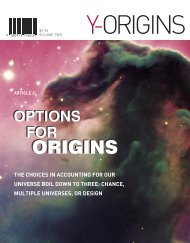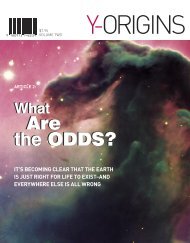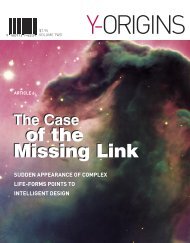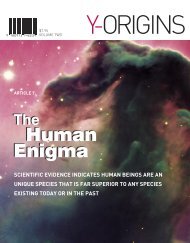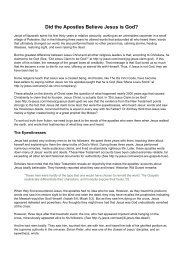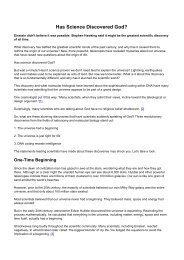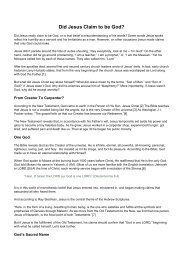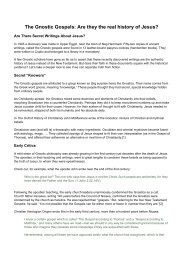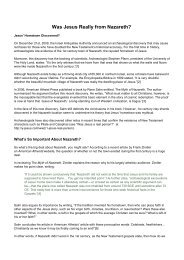Imagine8
You also want an ePaper? Increase the reach of your titles
YUMPU automatically turns print PDFs into web optimized ePapers that Google loves.
$7.95<br />
VOLUME TWO<br />
Y-ORIGINS<br />
ARTICLE 8:<br />
Back to<br />
Imagine<br />
The<br />
Beginning<br />
Designer<br />
DOES THE UNIVERSE REVEAL CLUES<br />
ABOUT THE NATURE OF ITS DESIGNER?<br />
IMAGINE THE DESIGNER • ARTICLE EIGHT
To view the layout and graphics, click on the Facing icon on the<br />
right side of your bottom tool bar in your Acrobat Reader © file. Try viewing at 75%.<br />
To read the article, click on the Single Page icon on the bottom right of your<br />
Acrobat Reader © file.<br />
To enlarge the print for easier viewing, click on the “+” by the<br />
magnifcation percentage in the middle of the tool bar at the top of the page.<br />
To move from one page to another, use your side scroll bar or click on the<br />
left or right arrow in the bottom tool bar.<br />
CLICK HERE to see other articles from Y-Jesus Magazine at www.y-zine.com<br />
Chief Editor: Larry Chapman<br />
Project Coordinator: Helmut Teichert<br />
Editorial Director: Rick James<br />
Design: Hydragraphik ® Studio ( www.hydragraphik.com )<br />
Sun Mountain Productions<br />
Article Editors: Rick James, Eric Stanford<br />
Copy Editor: Eric Stanford<br />
Writers: Larry Chapman, Rick James, Eric Stanford<br />
Y-ZINE<br />
PO Box 6017<br />
Great Falls, MT 59405<br />
Copyright 2006 by Bright Media Foundation and B & L Publications. All rights reserved.<br />
ISBN 0-9717422-3-5<br />
• IMAGINE THE DESIGNER • ARTICLE EIGHT
Imagine the Designer<br />
Click on the e-article title for contents<br />
IMAGINE THE DESIGNER Page 6<br />
ADMITTING THE APPEARANCE OF DESIGN Page 6<br />
ASKING DEEPER QUESTIONS Page 7<br />
WHAT KIND OF DESIGNER? Page 8<br />
HAS THE DESIGNER SPOKEN? Page 11<br />
NOTES Page 13<br />
QUOTES Page 14<br />
QUESTIONS ABOUT ORIGINS Page 16<br />
RECOMMENDED READING Page 18<br />
ACKNOWLEDGMENTS<br />
I am indebted to Dr. Bill Bright, who passed away before this project was finished. Dr. Bright enthusiastically endorsed and<br />
contributed to the development of the material presented in this endeavor.<br />
Special thanks are also due to Rick James and Eric Stanford, who have both spent countless hours clarifying some of the concepts<br />
presented.<br />
Several others have contributed greatly to the writing of these articles, including Dr. Henry Brandt, Dave Chapman, Dr. Bert<br />
Harned, and New Testament scholar, Dr. Ron Heine. The valuable input from Brian Ricci, ‘Jamin Latvala, and the Campus Crusade<br />
staff at the University of Washington were especially helpful and constructive. Special thanks also are due Helmut Teichert of<br />
Bright Media, who has been the overall director of the project. Finally I would like to thank my wife, Marianne, for inspiring me to<br />
undertake this effort.<br />
Larry Chapman<br />
IMAGINE THE DESIGNER • ARTICLE EIGHT
IMAGINE<br />
THE<br />
DESIGNER<br />
THE UNIVERSE<br />
NOT ONLY<br />
IMPLIES<br />
THE EXISTENCE OF A<br />
DESIGNER BUT<br />
SUGGESTS<br />
SOMETHING ABOUT<br />
WHAT HE MIGHT<br />
BE LIKE<br />
• IMAGINE THE DESIGNER • ARTICLE EIGHT
IMAGINE THE DESIGNER • ARTICLE EIGHT
In the movie Contact, Jodi Foster portrays<br />
Ellie Arroway, a beautiful young scientist<br />
obsessed with finding intelligent life on<br />
other planets. One day, as Ellie monitors<br />
radio transmissions from space, a coded<br />
message flashes across her computer<br />
screen. The stunned Ellie realizes that<br />
intelligent beings have communicated with<br />
Earth from beyond our galaxy.<br />
Decoding the instructions, Ellie and<br />
her colleagues discover the encrypted<br />
blueprint for an advanced spacecraft that<br />
will transport them to the distant galaxy,<br />
millions of light years from Earth. Once the<br />
spacecraft has been built, Ellie is chosen to<br />
become its sole passenger.<br />
Although Ellie’s boyfriend objects, her<br />
passion for meaning in life overpowers her<br />
love for him. Turning to him, Ellie explains<br />
her reason for leaving him: “I’ve been<br />
searching for something, some reason why<br />
we are here. What are we doing here? Who<br />
are we?”<br />
Ellie speaks for many of us who wonder<br />
about life. Who are we, and why are we<br />
here? (Actually, some of you may be<br />
wondering about more mundane things,<br />
like what’s for dinner, or what she thinks<br />
of you.)<br />
Has science, with its new discoveries in<br />
outer space and inside the molecular world,<br />
reached a point where it can shed light on<br />
such profound questions? Never has there<br />
been a more exciting time in the history<br />
of science. What does the fine-tuning of<br />
cosmos and intricate complexity of DNA<br />
mean to us?<br />
WHAT OR WHO IS<br />
BEHIND ALL THIS<br />
BRILLIANCE?<br />
HAS A DESIGNER<br />
LEFT ANY CLUES<br />
ABOUT HIS NATURE<br />
OR HIS PURPOSE?<br />
THESE ARE THE<br />
QUESTIONS<br />
SCIENTISTS, AS<br />
WELL AS THE REST<br />
OF US WHO ARE<br />
INTERESTED IN THE<br />
RESULTS OF THEIR<br />
EXPLORATION, ARE<br />
DRAWN TO ASK.<br />
ADMITTING<br />
THE<br />
APPEARANCE<br />
OF<br />
DESIGN<br />
In light of recent discoveries, many leading<br />
scientists have had their materialistic<br />
presuppositions challenged. One of those,<br />
Sir Fred Hoyle, was a world-renowned<br />
astronomer and founder of the Institute of<br />
Astronomy at Cambridge.<br />
Although Hoyle remained an agnostic, the<br />
brilliant astronomer remarked, “A common<br />
sense interpretation of the facts suggests<br />
that a superintellect has monkeyed with<br />
physics, as well as chemistry and biology.” 1<br />
Hoyle is not alone. Other great scientists<br />
have alluded to the compelling evidence<br />
for design in the universe, yet have been<br />
unwilling to ask the question of who<br />
planned it, or to delve into the reason<br />
behind the universe. Stephen Hawking<br />
admits scientists’ reticence to probe<br />
questions of our origins, stating, “There<br />
must be religious overtones. But I think<br />
most scientists prefer to shy away from the<br />
religious side of it.” 2<br />
However, there are scientists who are not<br />
so shy, and are asking profound questions:<br />
Why is the universe so finely-tuned for life?<br />
Has a designer left his fingerprints? Why<br />
are we here?<br />
6 • IMAGINE THE DESIGNER • ARTICLE EIGHT
“THERE MUST BE<br />
RELIGIOUS OVERTONES.<br />
BUT I THINK MOST<br />
SCIENTISTS PREFER TO<br />
SHY AWAY FROM THE<br />
RELIGIOUS SIDE OF IT.”<br />
STEPHEN HAWKING<br />
Here Hawking opens up new territory for<br />
scientists. Since Copernicus, and especially<br />
after Darwin, materialism had ruled the<br />
day in science. Any reference to God was<br />
scoffed at as a “God of the Gaps” argument,<br />
another way of saying “God is merely a<br />
stop-gap explanation for lack of knowledge,<br />
and has no place in our materialistic<br />
universe.” But now it is scientists who are<br />
actually initiating the discussion about an<br />
intelligent designer.<br />
ASKING<br />
DEEPER<br />
QUESTIONS<br />
Although Hawking tries to avoid religious<br />
discussion, he still asks,<br />
Theoretical astrophysicist George<br />
Greenstein, in his book, Symbiotic<br />
Universe, asks, “Is it possible that suddenly,<br />
without intending to, we have stumbled<br />
upon the scientific proof of the existence of<br />
a Supreme Being? Was it God who stepped<br />
in and so providentially crafted the cosmos<br />
for our benefit? 4<br />
What is it that breathes fire into the<br />
equations and makes a universe<br />
for them to describe? The usual<br />
approach of science of constructing a<br />
mathematical model cannot answer<br />
the questions of why there should be a<br />
universe for the model to describe.<br />
Up to now, most scientists have been<br />
too occupied with the development<br />
of new theories that describe what<br />
the universe is to ask the question<br />
why. On the other hand, the people<br />
whose business it is to ask why, the<br />
philosophers, have not been able to<br />
keep up with the advance of scientific<br />
Greenstein is a luminary in his field, being<br />
a professor of astronomy at Amherst<br />
College and a recipient of the Phi Beta<br />
Kappa Award in Science. This isn’t Forrest<br />
Gump here, scratching his head at the<br />
complexity of it all or attributing to God<br />
what he simply can’t grasp. Neither are<br />
other scientists who, like Greenstein, are<br />
looking at the scientific evidence and<br />
pondering the reality of God.<br />
theories. 3<br />
IMAGINING THE DESIGNER • ARTICLE EIGHT • A
WHAT<br />
KIND<br />
OF<br />
DESIGNER?<br />
If leading scientists like Greenstein are<br />
right in their conclusions that a designer<br />
exists, are there things that can be deduced<br />
about his nature from the observation of the<br />
universe? Why did he create us? Has he left<br />
any clues about our purpose here on planet<br />
Earth? Although these questions move<br />
beyond science into the realm of natural<br />
theology, they have been provoked by new<br />
discoveries in science.<br />
So, if a designer has left clues about<br />
himself, where would we look for them?<br />
To begin our search, we need to examine<br />
the universe to see if he has left his<br />
fingerprints. Just as the paintings of<br />
The Last Supper and Mona Lisa tell us<br />
something about their artist, Leonardo Da<br />
Vinci, and Beethoven’s Fifth Symphony<br />
reveals clues about its composer, we should<br />
be able to discern clues about a designer by<br />
observing his universe.<br />
Although scientific evidence only gives us<br />
a partial picture of what a designer is like,<br />
the universe does reveal some insightful<br />
clues about his nature.<br />
8 • IMAGINE THE DESIGNER • ARTICLE EIGHT
The following characteristics seem to<br />
emerge. The designer is a<br />
• purposeful designer<br />
• powerful designer<br />
• superintelligent designer<br />
• personal designer<br />
Once scientists discovered the remarkable<br />
fine-tuning of the universe, many reasoned<br />
there must be a purpose behind it. Paul<br />
Davies, one of the leading theoretical<br />
physicists in the world, writes, “If the<br />
universe has been designed by God, then<br />
must have a purpose.” 5<br />
Mathematician Roger Penrose –who, with<br />
Hawking, derived proof for the beginning<br />
time –offers his insight:<br />
There is a certain sense in which<br />
would say the universe has a purpose.<br />
It’s not there just somehow by chance.<br />
Some people take the view that the<br />
universe is simply there and it runs<br />
along –it’s a bit as though it just sort<br />
computes, and we happen by accident<br />
to find ourselves in this thing. I don’t<br />
think that’s a very fruitful or helpful<br />
way of looking at the universe. I think<br />
that there is something much deeper<br />
about it, about its existence, which<br />
we have very little inkling of at the<br />
moment. 6 Penrose deduces that the fine-tuning of<br />
physical constants (see article 3) for man’s<br />
existence is so improbable that it must<br />
have been intentionally planned. And it<br />
follows that whoever intentionally created<br />
the universe has a purpose that must<br />
include us. In his book, Superforce, Davies<br />
writes,<br />
The laws which enable the universe<br />
to come into being spontaneously<br />
seem themselves to be the product<br />
of exceedingly ingenious design. If<br />
physics is the product of design, the<br />
universe must have a purpose, and the<br />
evidence of modern physics suggests<br />
strongly to me that the purpose<br />
included us. 7<br />
If purpose is apparent from the fine-tuning<br />
of the universe, its awesome power is<br />
evident from startling new discoveries<br />
made possible by Hubble and other highpowered<br />
telescopes. Consider a few of the<br />
latest findings:<br />
• Black holes have such powerful<br />
gravitational force that even light<br />
cannot escape their grasp. Large ones<br />
gobble up stars like our Sun as mere<br />
snacks. (Maybe yummy…but a little<br />
too hot). 8<br />
• Supernova eruptions are so powerful<br />
that their light can rival the visual<br />
brightness of an entire galaxy with<br />
•<br />
Power<br />
and<br />
virtually<br />
with<br />
quasars.<br />
when<br />
demonstrated<br />
universe.<br />
at<br />
more<br />
and<br />
“IS<br />
SUDDENLY,<br />
INTENDING<br />
STUMBLED<br />
Gamma-ray bursts have the power<br />
of 10 billion billion suns. A single<br />
gamma-ray burst is capable<br />
of obliterating life on Earth in<br />
milliseconds. 11<br />
demonstrated by great earthquakes<br />
thermonuclear explosions would be<br />
insignificant when contrasted<br />
that of black holes, gamma-rays, or<br />
Yet, even those are miniscule<br />
compared with the power<br />
at the beginning of the<br />
Scientists are not only amazed<br />
the power within the cosmos, but even<br />
in awe of the power required to create<br />
control it all.<br />
IT POSSIBLE THAT<br />
WITHOUT<br />
TO, WE HAVE<br />
UPON THE<br />
it<br />
of<br />
I<br />
of<br />
100 billion suns. The resulting neutron<br />
star is so dense that on Earth, one<br />
teaspoonful would weigh a billion<br />
tons! 9<br />
• Quasars generate the energy of 100<br />
galaxies, shine with the intensity of a<br />
trillion suns, and reach temperatures<br />
of several million degrees. 10<br />
SCIENTIFIC PROOF OF THE<br />
EXISTENCE OF A SUPREME<br />
BEING? WAS IT GOD WHO<br />
STEPPED IN AND SO<br />
PROVIDENTIALLY CRAFTED<br />
THE COSMOS FOR<br />
OUR BENEFIT?”<br />
GEORGE GREENSTEIN,<br />
SYMBIOTIC UNIVERSE<br />
IMAGINING THE DESIGNER • ARTICLE EIGHT • A
Scientists are also in awe at the incredible<br />
genius behind the universe. Arguably<br />
the greatest mind in the history of<br />
science, Albert Einstein acknowledges<br />
that the mind behind the universe is a<br />
“superintelligence of such superiority<br />
that, compared with it, all the systematic<br />
thinking and acting of human beings is an<br />
utterly insignificant reflection.” 12 Einstein<br />
acknowledged this intelligence without<br />
ever defining it in personal terms.<br />
Perhaps with DNA engineering, man<br />
will discover ways to increase human<br />
intelligence or develop supercomputers far<br />
more advanced than Deep Blue, the IBM<br />
version that defeated Grandmaster Gary<br />
Kasparov in chess. But as Einstein notes,<br />
we can’t compare human genius with<br />
the intelligence of the one who designed<br />
it along with the universe and its laws<br />
of physics, quantum mechanics, and the<br />
intricate complexity of DNA?<br />
Astronomer Hugh Ross explains that it is<br />
impossible to impose any limit on either<br />
the power or intelligence of a transcendent<br />
Creator. 13 That is because the Creator<br />
would not be restricted by any of the<br />
constraints of our four-dimensional world–<br />
including time.<br />
Think for a minute of a being outside of<br />
time and the limitations of gravity and<br />
other natural forces. Our natural laws<br />
would have no power over him since he<br />
would be in complete control of them.<br />
And, being outside of time, he would know<br />
everything in the past–present–and future.<br />
But is the Creator of the universe merely<br />
an energy force like a microwave or is<br />
he personal like us? Is he aloof and nonrelational<br />
like The Force in Star Wars? If<br />
so, how was an impersonal force capable<br />
of creating personal, relational beings?<br />
This is the question that has puzzled both<br />
scientists and philosophers.<br />
In Contact, Ellie Arroway supposedly<br />
discovers the purpose she had been<br />
yearning for, but not from a personal<br />
creator. After returning from her encounter<br />
with an advanced civilization, Ellie tells her<br />
Christian friend Palmer,<br />
The story I have to tell you isn’t exactly<br />
about Punishment and Reward….<br />
There’s not a word in it about Jesus.<br />
Part of my message is that we’re not<br />
central to the purpose of the Cosmos. 14<br />
Ellie continues, “The universe was<br />
made on purpose….In whatever<br />
galaxy you happen to find yourself,<br />
you take the circumference of a<br />
circle, divide it by its diameter,<br />
measure closely enough, and uncover<br />
a miracle–another circle, drawn<br />
kilometers downstream of the decimal<br />
point. There would be richer messages<br />
farther in. It doesn’t matter what you<br />
look like, or what you’re made of, or<br />
where you come from. As long as<br />
you live in this universe, and have a<br />
modest talent for mathematics, sooner<br />
or later you’ll find it.” Sagan ends his<br />
novel with this message: “She found<br />
what she had been searching for.” 15<br />
10 • IMAGINE THE DESIGNER • ARTICLE EIGHT
NO ONE HAS EVER<br />
DEMONSTRATED<br />
HOW AN IMPERSONAL<br />
BEING CAN PRODUCE<br />
THE NEEDED<br />
COMPLEXITY<br />
OF THE UNIVERSE,<br />
LET ALONE THE<br />
PERSONALITY OF MAN<br />
FRANCIS SCHAEFFER<br />
Is it possible that an impersonal,<br />
mathematical force like Ellie’s circles is<br />
behind everything in the cosmos? In his<br />
book, The Kalam Cosmological Argument,<br />
Dr. William Lane Craig argues that it isn’t.<br />
He states that a beginning to the universe<br />
proves that its Creator is personal. Craig<br />
summarizes the possibilities:<br />
1. The universe either (a) had<br />
a beginning or (b) had no<br />
beginning.<br />
2. If it had a beginning, the<br />
beginning was either (a) caused<br />
or (b) uncaused.<br />
3. If it had a cause, the cause was<br />
either (a) personal or (b) not<br />
personal. 16<br />
Therefore, since the evidence clearly points<br />
to a universe that had a primary cause,<br />
it logically follows that the cause was<br />
personal. According to Craig, intelligence,<br />
volition (will), and power are all implied<br />
in the act of creating. If we think about a<br />
painting such as the Mona Lisa, we see the<br />
same things. Leonardo Da Vinci needed<br />
intelligence, volition, and power to paint<br />
the image he wanted to portray. These<br />
attributes point to Da Vinci being a person,<br />
and not a mere force.<br />
Philosopher Francis Schaeffer concurs,<br />
asserting, “No one has ever demonstrated<br />
how…an impersonal being can produce the<br />
needed complexity of the universe, let alone<br />
the personality of man.” 17<br />
HAS<br />
THE<br />
DESIGNER<br />
SPOKEN?<br />
Yet, in spite of these arguments for a<br />
personal creator, materialists remain<br />
unconvinced. They speak of a cold,<br />
uncaring universe that has originated by<br />
undirected forces blindly operating through<br />
eons of time. They believe in a universe<br />
without any purpose. But some startling<br />
new evidence recently brought forth seems<br />
to challenge their skepticism.<br />
In The Privileged Planet, theologian<br />
Jay Richards and astronomer Guillermo<br />
Gonzalez reveal a startling fact: Earth has<br />
been placed in an optimal location for<br />
scientific observation of our universe. 18<br />
In other words, if Earth was in a slightly<br />
different position in our solar system or<br />
galaxy, or located in another galaxy, we<br />
might find ourselves looking at a night sky<br />
with no stars to observe. Or the sky might<br />
be so flooded with light that we couldn’t<br />
distinguish one star from another. If we<br />
didn’t have this optimal position, many of<br />
the discoveries about our universe would<br />
have been impossible.<br />
IMAGINING THE DESIGNER • ARTICLE EIGHT • A
Imagine being in a large room with many<br />
seats and one tiny window with a view<br />
of space. One front row seat has a view,<br />
while the occupants of other seats can’t see<br />
out. Earth’s position in the universe is like<br />
having that front-row seat. Our front-row<br />
seat to the universe isn’t part of the finetuning<br />
requirement for life, but it seems<br />
to have been given to us intentionally.<br />
Richards and Gonzalez conclude that a<br />
designer wants us to know and understand<br />
his universe.<br />
At this point many might ask, “so what?<br />
How does that impact my life?” The<br />
obvious next question is, has a personal<br />
creator related to us in ways we can better<br />
understand? And if so, where do we look to<br />
discover more about his nature, and what<br />
he has said about our purpose?<br />
Agnostic George Smoot has remarked that<br />
an obvious parallel exists between the big<br />
bang and the Christian teaching of creation<br />
from nothing. 19 Smoot takes his inference<br />
to the Christian God no further, presumably<br />
leaving it for theologians.<br />
Theology, like philosophy or science, makes<br />
logical deductions –in this case, logical<br />
deductions about the nature of God. So<br />
let’s see what we can logically deduce from<br />
what science has told us about God. Since<br />
we have seen evidence from science and<br />
logic that the Creator of the universe is<br />
purposeful, powerful, superintelligent, and<br />
personal, he certainly would understand<br />
our desire to know more about him and his<br />
purpose for creating us.<br />
A creator who intentionally designed us<br />
with consciousness, personality, and the<br />
ability to communicate would be able to<br />
communicate with us if he so desired.<br />
Just as SETI is searching outer space for<br />
messages from intelligent beings in other<br />
galaxies, so we would expect a personal<br />
creator to have given us a message in a<br />
way we could understand. Of all creatures<br />
on Earth, humans are the only ones who<br />
are able to communicate propositional<br />
ideas –and we do it through written and<br />
spoken language.<br />
Although our brief attempt to make sense<br />
of the universe cannot possibly look at<br />
each religion or its god, Smoot’s assertion<br />
that a parallel exists between the scientific<br />
evidence for a beginning and the Christian<br />
teaching of creation deserves a deeper look.<br />
The Judeo-Christian Bible remarkably<br />
presents a God who is purposeful, powerful,<br />
superintelligent, and personal. It speaks<br />
of this God as an infinite, eternal Creator,<br />
who alone made everything there is from<br />
nothing. Although he is presented as a<br />
fearsome God of law and order, he is also<br />
shown to be a God of love who created us<br />
for a relationship with himself.<br />
Well, perhaps we should stop here. But we<br />
can’t resist taking our logic one more step.<br />
If God were really there, and if he revealed<br />
himself through science, and even through<br />
the written word, would that be sufficient?<br />
Would that show the highest order of care<br />
and communication? We’re persuaded that<br />
it would not.<br />
If you really love someone, sending them an<br />
email every month or so just wouldn’t cut<br />
it. Sooner or later, if you really care, you’ll<br />
be compelled to drop in for a visit –show up<br />
and get involved in his or her life.<br />
We close by suggesting that God may in<br />
fact have done just that –“shown up.”<br />
Here we leave physics and chemistry<br />
and biology, and turn to history, a field<br />
of human inquiry that can also provide<br />
knowledge about the real world.<br />
As we examine the history of mankind,<br />
is there any evidence that a designer has<br />
paid us a visit –and actually dropped in<br />
on us? Is it possible that God has visited<br />
Earth in human form? Many laugh at such<br />
an idea, recalling numerous ancient myths<br />
and legends that utter tales of superhuman<br />
gods visiting Earth. However, if the Creator<br />
paid us a visit, we would not be looking<br />
for a myth, but a real person who has<br />
transformed history.<br />
Whereas history records the feats of<br />
many great people, only one person has<br />
truly transformed history. Yale historian,<br />
Jaroslav Pelikan tells us his name: “Jesus<br />
of Nazareth has been the dominant figure<br />
in the history of Western culture for almost<br />
twenty centuries.” When the great secular<br />
historian, H. G. Wells was asked what<br />
person had the biggest impact upon world<br />
history, he answered, “By this test, Jesus<br />
stands first.”<br />
But historical impact is only one element of<br />
Jesus’ uniqueness. There are several other<br />
reasons why this one man is worthy of a<br />
deeper look. His life, his reported miracles,<br />
and his claims, convinced his followers that<br />
he was more than a mere man. They left a<br />
12 • IMAGINE THE DESIGNER • ARTICLE EIGHT
written record that Jesus was the one who<br />
put the stars in space, established the laws<br />
of the universe, and created you and me.<br />
But were they deluded? Or could the entire<br />
account of Jesus have been a conspiracy<br />
like The Da Vinci Code asserts? Was Jesus<br />
Christ just a great man who was later<br />
deified by the Roman emperor, Constantine<br />
and the fourth century church? Or are the<br />
written accounts in the New Testament<br />
right? Did the Creator actually drop in on<br />
us and pay us a visit?<br />
These all-important questions about<br />
this intriguing person are the subject of<br />
another investigation: Y-Jesus. In the Y-<br />
Jesus magazine which is about the most<br />
fascinating person in history, we examine<br />
evidence outside the Bible and tradition<br />
in order to solve the mystery of Jesus’ true<br />
identity. And if he is really who he claimed<br />
to be, we want to know what he said<br />
about you and me, and our purpose in the<br />
universe.<br />
As we contemplate our place on this<br />
remote planet in a universe of ten billion<br />
trillion stars, we come back to the question,<br />
are we accidents, or are we special? 18<br />
Materialist Stephen Jay Gould considered<br />
us lucky to be alive–”the glorious accident<br />
resulting from 60 trillion contingent<br />
events.” Yet, as leading scientists examine<br />
the universe, another picture is beginning<br />
to emerge. Many of these scientists are<br />
convinced that we are a divine conception,<br />
the intentional work of a powerful,<br />
superintelligent, purposeful designer. If<br />
true, we are special.<br />
As we examine<br />
the history<br />
of mankind,<br />
is there any<br />
evidence that<br />
a designer has<br />
paid us a visit<br />
–and actually<br />
dropped in<br />
on us?<br />
NOTES<br />
1. Fred Hoyle, “Let There Be Light,” Engineering<br />
and Science (November 1981).<br />
2. Quoted in John Boslough, Stephen<br />
Hawking’s Universe (New York: Avon,<br />
1989), 109.<br />
3. Stephen Hawking, A Brief History of<br />
Time, 174.<br />
4. George Greenstein, The Symbiotic<br />
Universe (New York: William Morrow,<br />
1988), 27.<br />
5. Paul Davies, God and the New Physics<br />
(New York: Simon & Schuster, Touchstone,<br />
1984), 199.<br />
6. Stephen Hawking, ed., Stephen Hawking’s<br />
A Brief History of Time: A Reader’s<br />
Companion (New York: Bantam, 1992), 142.<br />
7. Paul Davies, Superforce (New York:<br />
Simon & Schuster, 1984), 243.<br />
8. William Keel, “Quasars Explained,”<br />
Astronomy, vol. 31, no. 2 (February, 2003),<br />
42-47.<br />
9. Ibid. Alexei Fileppenko, “When Stars<br />
Explode,” 42-47.<br />
10. Keel, 35-41.<br />
11. Jan van Paradijs, “From Gamma-Ray<br />
bursts to Supernovae,” Science, 286 (1999)<br />
693-95.<br />
12. Albert Einstein, Ideas and Opinions—<br />
The World As I See It (New York: Bonanza,<br />
1931), 40.<br />
13. Hugh Ross, Beyond the Cosmos (Colorado<br />
Springs, CO: NavPress, 1996), 100–102.<br />
14. Carl Sagan, Contact (New York: Simon<br />
& Schuster, Pocket Books, 1985), 420.<br />
15. Ibid., 430, 431.<br />
16. William Lane Craig, The Kalam Cosmological<br />
Argument (Eugene, OR: Wipf &<br />
Stock, 2000), 63.<br />
17. Francis A. Schaeffer, He Is There and<br />
He Is Not Silent (Wheaton, IL: Tyndale<br />
House, 1976), 9.<br />
18. Guillermo Gonzalez and Jay W. Richards,<br />
The Privileged Planet (Washington,<br />
D.C.: Regnery, 2004).<br />
19. George Smoot & Keay Davidson,<br />
Wrinkles in Time (New York: Avon Books,<br />
1993), 17.<br />
IMAGINING THE DESIGNER • ARTICLE EIGHT • A
QUOTES<br />
FRED HOYLE (BRITISH<br />
ASTROPHYSICIST)<br />
“A common sense interpretation of the<br />
facts suggests that a superintellect has<br />
monkeyed with physics, as well as with<br />
chemistry and biology, and that there are no<br />
blind forces worth speaking about in nature.<br />
The numbers one calculates from the facts<br />
seem to me so overwhelming as to put this<br />
conclusion almost beyond question.”<br />
GEORGE ELLIS (BRITISH<br />
ASTROPHYSICIST)<br />
“Amazing fine tuning occurs in the laws<br />
that make this [complexity] possible. Realization<br />
of the complexity of what is accomplished<br />
makes it very difficult not to use the<br />
word ‘miraculous’ without taking a stand as<br />
to the ontological status of the word.”<br />
PAUL DAVIES (BRITISH<br />
ASTROPHYSICIST)<br />
“There is for me powerful evidence that<br />
there is something going on behind it all. It<br />
seems as though somebody has fine-tuned<br />
nature’s numbers to make the Universe.<br />
The impression of design is overwhelming.”<br />
ALAN SANDAGE (WINNER<br />
OF THE CRAWFORD PRIZE<br />
IN ASTRONOMY)<br />
“I find it quite improbable that such order<br />
came out of chaos. There has to be some<br />
organizing principle. God to me is a mystery<br />
but is the explanation for the miracle of<br />
existence, why there is something instead<br />
of nothing.”<br />
JOHN O’KEEFE<br />
(NASA ASTRONOMER)<br />
“We are, by astronomical standards, a<br />
pampered, cosseted, cherished group of<br />
creatures. If the universe had not been made<br />
with the most exacting precision we could<br />
never have come into existence. It is my<br />
view that these circumstances indicate the<br />
universe was created for man to live in.”<br />
GEORGE GREENSTEIN<br />
(ASTRONOMER)<br />
“As we survey all the evidence, the thought<br />
insistently arises that some supernatural<br />
agency—or, rather, Agency—must<br />
be involved. Is it possible that suddenly,<br />
without intending to, we have stumbled<br />
upon scientific proof of the existence of a<br />
Supreme Being? Was it God who stepped in<br />
and so providentially crafted the cosmos for<br />
our benefit?”<br />
ARTHUR EDDINGTON<br />
(ASTROPHYSICIST)<br />
“The idea of a universal mind or Logos<br />
would be, I think, a fairly plausible inference<br />
from the present state of scientific<br />
theory.”<br />
ARNO PENZIAS (NOBEL<br />
PRIZE IN PHYSICS)<br />
“Astronomy leads us to a unique event, a<br />
universe which was created out of nothing,<br />
one with the very delicate balance needed<br />
to provide exactly the conditions required to<br />
permit life, and one which has an underlying<br />
(one might say ‘supernatural’) plan.”<br />
ROGER PENROSE<br />
(MATHEMATICIAN AND<br />
AUTHOR)<br />
“I would say the universe has a purpose. It’s<br />
not there just somehow by chance.”<br />
14 • QUOTES
TONY ROTHMAN<br />
TONY ROTHMAN<br />
(PHYSICIST)<br />
(PHYSICIST)<br />
“It seems to me that when confronted with<br />
“When confronted with the order and<br />
“It seems to me that when confronted with<br />
“When confronted with the order and<br />
ED HARRISON<br />
the marvels of life and the universe, one<br />
beauty of the universe and the strange ED HARRISON<br />
the marvels of life and the universe, one<br />
beauty of the universe and the strange (COSMOLOGIST)<br />
must ask why and not just how. The only<br />
coincidences of nature, it’s very tempting (COSMOLOGIST)<br />
coincidences of nature, it’s very tempting “Here is the cosmological proof of the<br />
must ask why and not just how. The only<br />
to take the leap of faith from science into<br />
“Here is the cosmological proof of the possible answers are religious. . . . I find a<br />
to take the leap of faith from science into existence of God—the design argument of<br />
possible answers are religious. . . . I find a<br />
religion. I am sure many physicists want to.<br />
existence of God—the design argument need of for God in the universe and in my own<br />
religion. I am sure many physicists want Paley—updated to. and refurbished. The fine<br />
need for God in the universe and in my own<br />
I only wish they would admit it.”<br />
Paley—updated and refurbished. The fine life.”<br />
I only wish they would admit it.” tuning of the universe provides prima facie<br />
life.”<br />
tuning of the universe provides prima facie<br />
evidence of deistic design. Take your choice:<br />
evidence of deistic design. Take your choice:<br />
blind chance that requires multitudes of<br />
blind chance that requires multitudes of<br />
universes or design that requires only one.<br />
universes or design that requires only one.<br />
Many scientists, when they admit their<br />
Many scientists, when they admit their<br />
VERA KISTIAKOWSKY<br />
views, incline toward the teleological or<br />
VERA KISTIAKOWSKY<br />
views, incline toward the teleological or<br />
design argument.”<br />
(MIT PHYSICIST)<br />
design argument.”<br />
(MIT PHYSICIST)<br />
“The exquisite order displayed by our scientific<br />
understanding of the physical world<br />
FER (COMPUTATIONAL<br />
HENRY “FRITZ” SCHAE-<br />
“The exquisite order displayed by our scientific<br />
understanding of the physical world<br />
FER (COMPUTATIONAL<br />
HENRY “FRITZ” SCHAEcalls<br />
for the divine.”<br />
EDWARD MILNE<br />
QUANTUM CHEMIST)<br />
calls for the divine.”<br />
EDWARD MILNE<br />
QUANTUM CHEMIST)<br />
(BRITISH COSMOLOGIST) “The significance and joy in my science<br />
(BRITISH COSMOLOGIST) “The significance and joy in my science<br />
“As to the cause of the Universe, in context comes in those occasional moments of<br />
“As to the cause of the Universe, in context<br />
of expansion, that is left for the reader to insert,<br />
but our picture is incomplete without<br />
comes in those occasional moments of<br />
of expansion, that is left for the reader discovering to insert,<br />
but our picture is incomplete without myself, ‘So that’s how God did it.’ My goal<br />
something new and saying to<br />
discovering something new and saying to<br />
STEPHEN HAWKING<br />
STEPHEN HAWKING<br />
(BRITISH ASTROPHYSICIST)<br />
Him [God].”<br />
myself, ‘So that’s how God did it.’ My goal<br />
(BRITISH ASTROPHYSICIST)<br />
Him [God].”<br />
is to understand a little corner of God’s<br />
“What is it that breathes fire into the equations<br />
and makes a universe for them to<br />
plan.”<br />
is to understand a little corner of God’s<br />
“What is it that breathes fire into the equations<br />
and makes a universe for them to<br />
plan.”<br />
describe? …<br />
BARRY PARKER<br />
describe? …<br />
BARRY PARKER<br />
(COSMOLOGIST)<br />
(COSMOLOGIST)<br />
ARTHUR L. SCHAWLOW<br />
ARTHUR L. SCHAWLOW<br />
(PROFESSOR OF PHYSICS<br />
(PROFESSOR OF PHYSICS<br />
AT STANFORD UNIVER-<br />
AT STANFORD UNIVER-<br />
SITY, 1981 NOBEL PRIZE<br />
SITY, 1981 NOBEL PRIZE<br />
IN PHYSICS)<br />
IN PHYSICS)<br />
WERNHER VON BRAUN<br />
WERNHER VON BRAUN<br />
Up to now, most scientists have been too “Who created these laws? There is no question<br />
but that a God will always be needed.” (PIONEER ROCKET<br />
Up to now, most scientists have been too “Who created these laws? There is no question<br />
but that a God will always be needed.” ENGINEER)<br />
occupied with the development of new<br />
(PIONEER ROCKET<br />
occupied with the development of new<br />
theories that describe what the universe is<br />
theories that describe what the universe is<br />
ENGINEER)<br />
to ask the question why?”<br />
“I find it as difficult to understand a<br />
to ask the question why?”<br />
“I find it as difficult to understand a<br />
scientist who does not acknowledge the<br />
scientist who does not acknowledge the<br />
presence of a superior rationality behind<br />
presence of a superior rationality behind<br />
ALEXANDER POLYAKOV<br />
ALEXANDER POLYAKOV<br />
the existence of the universe as it is to<br />
(SOVIET MATHEMATICIAN)<br />
the existence of the universe as it is to<br />
(SOVIET MATHEMATICIAN)<br />
comprehend a theologian who would deny<br />
“We know that nature is described by the<br />
comprehend a theologian who would deny<br />
“We know that nature is described by the<br />
the advances of science.”<br />
best of all possible mathematics because DRS. ZEHAVI, AND DEKEL<br />
the advances of science.”<br />
best of all possible mathematics because DRS. ZEHAVI, AND DEKEL<br />
God created it.”<br />
(COSMOLOGISTS)<br />
God created it.”<br />
(COSMOLOGISTS)<br />
“This type of universe, however, seems to<br />
“This type of universe, however, seems to<br />
require a degree of fine tuning of the initial<br />
require a degree of fine tuning of the initial<br />
conditions that is in apparent conflict with<br />
conditions that is in apparent conflict with<br />
‘common wisdom’.”<br />
‘common wisdom’.”<br />
QUOTES • 15
ABOUT ORIGINS<br />
QUESTIONS<br />
Q. WHAT NEW DISCOVERY IN<br />
ASTRONOMY HAS PROVOKED<br />
MANY LEADING SCIENTISTS TO<br />
RETHINK THE ORIGIN OF OUR<br />
UNIVERSE?<br />
A. Most scientists thought the universe<br />
had always existed until Edwin Hubble<br />
observed that the universe is expanding.<br />
Scientists now believe that the<br />
universe originated with a one-time explosion<br />
of incredible force called, “the<br />
big bang.” But scientists wonder how<br />
everything in our cosmos could come<br />
from nothing. Something or someone<br />
must have been there to cause it to<br />
begin. Astrophysicist George Smoot<br />
(an agnostic) said, “If you’re religious,<br />
it’s like looking at God.”<br />
(See article 1)<br />
Q. HOW COULD A “BIG BANG”<br />
RANDOMLY RESULT IN THE<br />
CONDITIONS NECESSARY FOR<br />
LIFE?<br />
A. Scientists have calculated that several<br />
conditions vital for life needed to be<br />
fine-tuned to a razor’s edge. Without<br />
this precise fine-tuning, our universe<br />
wouldn’t exist, let alone support life.<br />
Leading astrophysicist Stephen Hawking<br />
writes, “The odds against a universe<br />
like ours emerging out of something<br />
like a big bang are enormous....<br />
I think there are religious implications<br />
whenever you start to discuss the<br />
origins of the universe.” (See article 2)<br />
Q. HOW DO SCIENTISTS<br />
ACCOUNT FOR SUCH<br />
INCREDIBLE ODDS AGAINST<br />
LIFE EXISTING ON EARTH?<br />
A. Many scientists admit that a finely-tuned<br />
universe, and a “just right” solar system<br />
and planet couldn’t have happened without<br />
a superintelligence. Others chalk it up<br />
to an incredible coincidence.<br />
A few prefer to believe a speculative<br />
theory, that there may an astronomical<br />
number of universes, and that ours<br />
just happens to be the one that supports<br />
life. However, theoretical physicist, Paul<br />
Davies confides what many scientists<br />
conclude, “It seems as though somebody<br />
has fine-tuned nature’s numbers to make<br />
the Universe....The impression of design<br />
is overwhelming.”<br />
(See article 3)<br />
Q. COULD INTRICATE OR-<br />
GANS LIKE THE EYE HAVE<br />
EVOLVED BY UNGUIDED<br />
NATURAL PROCESSES?<br />
A. Darwinian natural selection doesn’t<br />
explain how the eye’s many individual<br />
components could independently evolve,<br />
yet synchronize together to produce sight.<br />
Several molecular biologists conclude<br />
that irreducibly complex systems, like the<br />
eye, have been designed. Even Darwin<br />
admitted that the eye still gave him a<br />
“cold shudder.” (See article 4)<br />
16 • IMAGINE THE DESIGNER • ARTICLE EIGHT
Q.<br />
Q. CAN CAN DNA’S DNA’S DETAILED DETAILED<br />
CODING CODING BE BE EXPLAINED<br />
EXPLAINED<br />
BY BY NATURAL NATURAL PROCESS- PROCESS-<br />
ES? ES?<br />
A.<br />
A. DNA’s intricate complexity caused its<br />
DNA’s intricate complexity caused its<br />
co-discoverer, Francis Crick, to call it<br />
co-discoverer, Francis Crick, to call it<br />
“almost a miracle.” Since no scientific<br />
“almost miracle.” Since no scientific<br />
process, including natural selection,<br />
process, including natural selection,<br />
is able to explain DNA’s origin, many<br />
is able to explain DNA’s origin, many<br />
scientists believe that it must have<br />
scientists believe that it must have<br />
been designed. Antony Flew was<br />
been designed. Antony Flew was<br />
so impressed by the genius behind<br />
so impressed by the genius behind<br />
DNA that he renounced 50 years of<br />
DNA that he renounced 50 years of<br />
atheistic leadership, arguing that<br />
atheistic leadership, arguing that<br />
DNA must have been designed by a<br />
DNA must have been designed by superior intelligence. (See article 5)<br />
superior intelligence. (See article 5)<br />
Q.<br />
Q. DOES DOES EVIDENCE EVIDENCE<br />
SUPPORT SUPPORT DARWIN’S DARWIN’S<br />
THEORY THEORY THAT THAT ALL ALL LIFE LIFE<br />
EVOLVED EVOLVED BY BY UNDIRECTED<br />
UNDIRECTED<br />
NATURAL NATURAL PROCESSES?<br />
PROCESSES?<br />
A.<br />
A. Evidence supports Darwin’s theory of<br />
Evidence supports Darwin’s theory of<br />
microevolution, where environmental<br />
adaptations result in variations<br />
microevolution, where environmental<br />
adaptations result in variations<br />
within a single population, such as a<br />
within single population, such as species. This is why viruses mutate,<br />
species. This is why viruses mutate,<br />
house insects have evolved resistance<br />
house insects have evolved resistance<br />
to our pesticides, and dogs, cats,<br />
to our pesticides, and dogs, cats,<br />
and humans, come in various shapes<br />
and humans, come in various shapes<br />
sizes and colors. Scientists are correct<br />
sizes and colors. Scientists are correct<br />
when they state Darwinian microevolution<br />
is factual.<br />
when they state Darwinian microevolution<br />
is factual.<br />
However, Darwin’s theory of macroevolution,<br />
says that over time, undi-<br />
However, Darwin’s theory of macroevolution,<br />
says that over time, undirected<br />
natural processes led to all life<br />
rected natural processes led to all life<br />
forms, from the most primitive cell to<br />
forms, from the most primitive cell to<br />
human beings. He predicted countless<br />
fossils would prove him right.<br />
human beings. He predicted countless<br />
fossils would prove him right.<br />
But the transitional fossils Darwin<br />
But the transitional fossils Darwin<br />
predicted would validate macroevolution<br />
are embarrassingly absent. Even<br />
predicted would validate macroevolution<br />
are embarrassingly absent. Even<br />
ardent evolutionist, Niles Eldredge<br />
ardent evolutionist, Niles Eldredge<br />
admits, “No one has found any such<br />
admits, “No one has found any such<br />
in-between creatures...and there is<br />
in-between creatures...and there is<br />
a growing conviction among many<br />
growing conviction among many<br />
scientists that these transitional forms<br />
scientists that these transitional forms<br />
never existed.” (See article 6)<br />
never existed.” (See article 6)<br />
Q.<br />
Q. WHAT WHAT DO DO DNA DNA AND AND THE THE<br />
FOSSIL FOSSIL TRAIL TRAIL REVEAL REVEAL<br />
ABOUT ABOUT HUMAN HUMAN ORIGINS? ORIGINS?<br />
A.<br />
A. Mitochondrial DNA studies have<br />
Mitochondrial DNA studies have<br />
shown that our species originated from<br />
shown that our species originated from<br />
one location, and one mother (they<br />
one location, and one mother (they<br />
call Eve). Although fossil hunters have<br />
call Eve). Although fossil hunters have<br />
discovered a few extinct species of<br />
discovered few extinct species of<br />
hominids, these creatures are vastly<br />
hominids, these creatures are vastly<br />
inferior to humans in their intellectual<br />
inferior to humans in their intellectual<br />
capacities. Thus paleoanthropologists<br />
capacities. Thus paleoanthropologists<br />
remain baffled by the single origin and<br />
remain baffled by the single origin and<br />
sudden appearance of Homo sapiens<br />
sudden appearance of Homo sapiens<br />
in the fossil trail. (See article 7)<br />
in the fossil trail. (See article 7)<br />
Q.<br />
Q. IF IF A DESIGNER DESIGNER EXISTS, EXISTS,<br />
HAS HAS HE HE GIVEN GIVEN US US CLUES CLUES<br />
THAT THAT REVEAL REVEAL WHAT WHAT HE HE IS IS<br />
LIKE? LIKE?<br />
A.<br />
A. Many scientists believe that a designer<br />
has put his “fingerprints” on<br />
Many scientists believe that designer<br />
has put his “fingerprints” on<br />
the cosmos. Theoretical physicist<br />
the cosmos. Theoretical physicist<br />
Paul Davies writes, “If physics is the<br />
Paul Davies writes, “If physics is the<br />
product of design, the universe must<br />
product of design, the universe must<br />
have a purpose, and the evidence of<br />
have purpose, and the evidence of<br />
modern physics suggests strongly to<br />
modern physics suggests strongly to<br />
me, that the purpose included us.”<br />
me, that the purpose included us.”<br />
The evidence seems to indicate that<br />
The evidence seems to indicate that<br />
the designer is not just purposeful, but<br />
the designer is not just purposeful, but<br />
that he is also personal, superintelligent,<br />
and immensely powerful.<br />
that he is also personal, superintelligent,<br />
and immensely powerful.<br />
(See article 8)<br />
(See article 8)<br />
Q. WHY DO SCIENTISTS DIS-<br />
AGREE ABOUT THE EVI-<br />
DENCE FOR DESIGN?<br />
A. Some scientists, regardless of the evidence,<br />
cannot accept intelligent design<br />
because they are adamantly opposed<br />
to the possibility that God is involved<br />
in the development of life. Others deny<br />
the existence of any higher power. Like<br />
Stephen Jay Gould, they believe that<br />
we are merely “cosmic accidents.”<br />
On the other hand, an increasing<br />
number of scientists have recognized<br />
evidence for intelligent design behind<br />
all the laws of science and the fine-tuning<br />
in the universe. Intelligent design<br />
proponents advocate “following the<br />
evidence, wherever it leads.”<br />
Q. ARE INTELLIGENT DESIGN<br />
AND BIBLICAL CREATION-<br />
ISM THE SAME?<br />
A. Although some mistakenly lump them<br />
together, their premise is so different it’s<br />
like comparing apples and oranges. Biblical<br />
creationism looks at science through<br />
the lens of Genesis, whereas intelligent<br />
design draws its inferences about our<br />
origins from scientific discoveries without<br />
any such filter. Intelligent design advocates<br />
vary in their religious beliefs, and<br />
leave the identity of the designer to theologians.<br />
Biblical creationists, on the other<br />
hand, specify the designer as the Judeo-<br />
Christian God. An increasing number of<br />
scientists believe that the discoveries in<br />
science point more and more to a position<br />
totally consistent with the Bible.<br />
ABOVE QUESTIONS FOR FACILITATING INDIVIDUAL OR GROUP STUDY<br />
IMAGINING THE DESIGNER • ARTICLE EIGHT • A
The following books are recommended as<br />
additional resources on both the origin of<br />
the universe and the origin of life. Although<br />
different viewpoints are expressed<br />
in these materials, they are recommended<br />
for a reader’s better understanding of the<br />
subjects.<br />
THE PRIVILEGED PLANET,<br />
GUILLERMO GONZALEZ &<br />
JAY RICHARDS<br />
A unique perspective on cosmology which<br />
systematically builds the argument that<br />
planet Earth is not merely designed for<br />
human life, but also human discovery of the<br />
cosmos. For the serious science reader.<br />
COSMOLOGY:<br />
RECOM-<br />
BEYOND EINSTEIN:<br />
THE COSMIC QUEST<br />
FOR THE THEORY OF<br />
THE UNIVERSE<br />
MICHIO KAKU &<br />
JENNIFER THOMPSON<br />
A compelling read on the history of string<br />
theory in theoretical physicists’ quest to<br />
solve the riddle of how two radically different<br />
principles, quantum physics and relativity,<br />
can both operate within the cosmos.<br />
THE ELEGANT UNIVERSE,<br />
BRIAN GREENE<br />
Greene attempts to take the very difficult<br />
science of string theory and make it<br />
interesting. This material has become the<br />
subject of a PBS television special by the<br />
same name.<br />
MENDED<br />
BOOKS<br />
WRINKLES IN TIME,<br />
GEORGE SMOOT &<br />
KEAY DAVIDSON<br />
This well written book provides a chronology<br />
of how scientists discovered the birth<br />
of the universe and confirmed its beginning<br />
with the COBE Satellite’s remarkable discovery.<br />
Smoot recalls his personal experiences<br />
as head of the project.<br />
18 • IMAGINE THE DESIGNER • ARTICLE EIGHT
:<br />
DARWIN’S BLACK BOX,<br />
MICHAEL J. BEHE<br />
DARWIN’S BLACK BOX,<br />
MICHAEL J. BEHE<br />
Behe writes a compelling case for intelligent<br />
design from a biochemist’s perspective.<br />
This is a must read for anyone<br />
wanting to understand the scientific basis<br />
for the Intelligent Design movement in<br />
science.<br />
Behe writes a compelling case for intelligent<br />
design from a biochemist’s perspective.<br />
This is a must read for anyone wanting<br />
to understand the scientific basis for the<br />
EVOLUTION: A THEORY<br />
IN CRISIS,<br />
MICHAEL DENTON<br />
Intelligent Design movement in science.<br />
EVOLUTION: A THEORY<br />
IN CRISIS,<br />
MICHAEL DENTON<br />
Molecular biologist Denton unveils scientific<br />
evidence which exposes Darwinian<br />
macro-evolutionary claims, pointing out<br />
Molecular biologist Denton unveils scientific<br />
evidence which exposes Darwinian<br />
its failure to fulfill Darwin’s promises and<br />
macro-evolutionary claims, pointing out<br />
expectations.<br />
its failure to fulfill Darwin’s promises and<br />
SCALING THE<br />
SECULAR CITY<br />
J. P. MORELAND<br />
expectations.<br />
SCALING THE<br />
SECULAR CITY<br />
J. P. MORELAND<br />
Dr. Moreland addresses the issues of how<br />
cosmology and biology interface with<br />
Dr. Moreland addresses the issues of how<br />
the Bible and Christianity. A professor<br />
cosmology and biology interface with<br />
the Bible and Christianity. A professor<br />
of philosophy and lecturer on the college<br />
campus, Moreland brilliantly deals<br />
of philosophy and lecturer on the college<br />
with the issues, arguments, and counter<br />
campus, Moreland brilliantly deals with the<br />
arguments at the forefront of the debate<br />
issues, arguments, and counter arguments<br />
between naturalism and theism.<br />
at the forefront of the debate between naturalism<br />
and theism.<br />
THE CASE FOR<br />
A CREATOR,<br />
LEE STROBEL<br />
THE CASE FOR<br />
A CREATOR,<br />
LEE STROBEL<br />
Former atheist Lee Strobel speaks with<br />
Former atheist Lee Strobel speaks with<br />
several leading scientists as he investigates<br />
several leading scientists as he investigates<br />
the evidence for creation. Investigative<br />
reporter, Strobel writes as a<br />
the evidence for creation. Investigative<br />
laymen, but tackles the difficult science<br />
reporter, Strobel writes as a laymen, but<br />
tackles the difficult science issues with a<br />
issues with a mixture of humor, intelligence,<br />
and compelling interest.<br />
mixture of humor, intelligence, and compelling<br />
interest.<br />
THE DESIGN<br />
REVOLUTION,<br />
WILLIAM A. DEMBSKI<br />
THE DESIGN<br />
REVOLUTION,<br />
WILLIAM A. DEMBSKI<br />
Dembski has brilliantly laid out the scientific<br />
basis for intelligent design. In this<br />
book he answers the toughest questions<br />
Dembski has brilliantly laid out the<br />
that have been asked by both skeptics and<br />
scientific basis for intelligent design.<br />
creationists.<br />
In this book he answers the toughest<br />
questions that have been asked by both<br />
SHOW ME GOD,<br />
FRED HEEREN<br />
skeptics and creationists.<br />
SHOW ME GOD,<br />
FRED HEEREN<br />
This excellent read asks the question, “Is<br />
God evident in the universe?” Heeren<br />
speaks with several leading scientists in<br />
This excellent read asks the question, “Is<br />
an interview format, weaving in several<br />
God evident in the universe?” Heeren<br />
interesting fictional stories for interest and<br />
speaks with several leading scientists in<br />
clarity.<br />
an interview format, weaving in several<br />
interesting fictional stories for interest<br />
THE STRUCTURE<br />
OF SCIENTIFIC<br />
REVOLUTIONS,<br />
THOMAS S. KUHN<br />
and clarity.<br />
THE STRUCTURE<br />
OF SCIENTIFIC<br />
REVOLUTIONS,<br />
THOMAS S. KUHN<br />
Considered by some as one of the most<br />
influential books of all time, Kuhn reveals<br />
how the scientific establishment is adverse<br />
Considered by some as one of the most<br />
influential books of all time, Kuhn reveals<br />
to changing positions, even when new evidence<br />
proves the former paradigm as wrong.<br />
Although this is a book about science rather<br />
how the scientific establishment is adverse<br />
to changing positions, even when<br />
new evidence proves the former paradigm<br />
than a scientific treatise, it provides some insight<br />
into why naturalists are so vehemently<br />
as wrong. Although this is a book about<br />
opposed to intelligent design.<br />
science rather than a scientific treatise, it<br />
provides some insight into why naturalists<br />
are so vehemently opposed to intelligent<br />
design.<br />
A BRIEF HISTORY OF<br />
TIME,<br />
STEPHEN HAWKING<br />
A BRIEF HISTORY OF<br />
TIME,<br />
STEPHEN HAWKING<br />
The best-selling science book of all time<br />
written by the world’s leading theoretical<br />
physicist. Hawking traces the history of<br />
cosmology, probing, but not answering the<br />
The best-selling science book of all time<br />
question of why the universe came into<br />
written by the world’s leading theoretical<br />
existence.<br />
physicist. Hawking traces the history of<br />
cosmology, probing, but not answering<br />
the question of why the universe came<br />
into existence.<br />
Y-ZINE PUBLICATIONS:<br />
DISCOVER IN Y-JESUS:<br />
BORN IDENTITY<br />
Was Jesus A Real Person?<br />
JESUS COMPLEX<br />
Was He Crazy, A Pathological Liar, Or<br />
The Son Of God?<br />
MONA LISA’S SMIRK<br />
The Truth Behind The Da Vinci<br />
Conspiracy<br />
JESUS.DOC<br />
Is The New Testament Reliable?<br />
THE PATH LAID BY PROPHETS<br />
Was The Messiah’s Identity Encrypted<br />
Within Ancient Hebrew Prophecy?<br />
BODY COUNT<br />
Explaining The Disappearance And<br />
Reappearance Of Jesus?<br />
WHY JESUS?<br />
Is He Relevant Today?<br />
To get a copy of Y-Origins magazine<br />
or to order more copies of Y-Jesus,<br />
visit www.Y-Zine.com<br />
or mail $7.95 per magazine to:<br />
Y-Zine<br />
P.O. BOX 6017<br />
Great Falls, MT 59405<br />
(Shipping & handling is free!)<br />
IMAGINING THE DESIGNER • ARTICLE EIGHT • A
“IMAGINE THE DESIGNER” IS ONE OF EIGHT ARTICLES FROM<br />
Y-ORIGINS MAGAZINE<br />
Back to the Beginning<br />
Scientific discoveries revive the ancient belief in a beginning to the universe.<br />
What are the Odds?<br />
It’s becoming clear that life on earth is unique and the odds against it existing elsewhere are<br />
astronomical.<br />
Options for Origins<br />
The choices in accounting for out universe boil down to three -—chance, multiple universes, or design.<br />
The Problem with Half an Eye<br />
Can intricately complex organs like the eye be the result of time plus chance?<br />
The Language of Our Cells<br />
Does the intelligence of DNA point to a Designer?<br />
The Case of the Missing Links<br />
Where are Darwin’s predicted fossils?<br />
DISCOVER IN Y-ORIGINS:<br />
Leading scientists like Einstein admit to a “superintelligence.”<br />
DNA causes leading atheist to renounce 50 years of unbelief<br />
DNA stuns evolutionists by tracing all humans to a single parent<br />
The Human Enigma<br />
Evolutionists are unable to explain the origin of human intelligence and consciousness.<br />
Imagine the Designer<br />
Does the universe reveal clues about the nature of its designer?<br />
New theories predict other dimensions that make “miracles” possible<br />
The Creator has left clues in the cosmos that tell us what He is like.<br />
This colorful, easy-to-read magazine provides startling insights about our<br />
origins from such leading scientists as Stephen Hawking, Stephen Jay Gould,<br />
Roger Penrose, and Paul Davies.In his review of Y-Origins Jon Greene writes,<br />
“Y-Origins is a wonderful work on intelligent design, designed to appeal to the<br />
Y-generation. For readers who have never been exposed to the evidence for<br />
intelligent design, Y-Origins is a great introduction.”<br />
CLICK HERE to read excerpts from these articles at www.y-Jesus.com<br />
20 • IMAGINE THE DESIGNER • ARTICLE EIGHT
HELPFUL WEBSITES<br />
IN YOUR DISCOVERY OF THE REAL JESUS:<br />
Y-Origins Connection<br />
Articles, links and resources about new scientific discoveries<br />
that support intelligent design.<br />
www.y-Origins.com<br />
Y-Jesus Magazine<br />
investigates<br />
the evidence for<br />
Jesus Christ.<br />
Discovery Institute<br />
Discovery Institute is a nonpartisan public policy think tank<br />
conducting research on technology, science and culture,<br />
economics and foreign affairs.<br />
www.discovery.com<br />
Origins<br />
Dedicated to intelligent design and philosophical theism, this<br />
site features articles by William A. Dembski, discussions on<br />
creation, evolution, theism, and atheism.<br />
www.origins.org<br />
Access Research Network on<br />
Origins and Design<br />
A site dedicated to providing accessible information<br />
on science, technology and society. It focuses on such<br />
controversial topics as genetic engineering, euthanasia,<br />
computer technology, environmental issues, creation/<br />
evolution, fetal tissue research, AIDS, etc.<br />
www.arn.org<br />
Would You Like to Know God<br />
Personally?<br />
God loves you and wants you to know Him intimately. Four<br />
principles will help you discover how to know God personally<br />
and experience the abundant life He promised.<br />
www.KnowGodPersonally.org<br />
WE WOULD LIKE TO HEAR FROM YOU.<br />
CLICK HERE to give us your comments<br />
DISCOVER IN Y-JESUS<br />
• Scholars examine the facts<br />
• Relevant illustrations<br />
• Dramatic photos<br />
• Contemporary graphics<br />
• Easy to read and understand<br />
Y-Jesus is a full color,<br />
100 page magazine.<br />
To get a copy of<br />
Y-Origins Magazine<br />
visit www.Y-zine.com<br />
or mail $7.95 per magazine to:<br />
Y-Zine<br />
P.O. BOX 6017<br />
Great Falls, MT 59405<br />
(Shipping & handling is free<br />
in continental United States)<br />
IMAGINING THE DESIGNER • ARTICLE EIGHT • A



